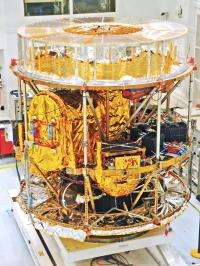MSG-3 satellite ready to continue weather-monitoring service

(PhysOrg.com) -- International partners are looking ahead to the newest member in a series of weather satellites that deliver images to European forecasters: MSG-3 is set for launch this summer.
The Meteosat Second Generation (MSG) satellites are designed to improve weather prediction.
The first in the series, MSG-1 – also known as Meteosat-8 – was launched in 2002. MSG-2 followed three years later. Both have been successful in continuing the legacy of the operational meteorological satellites that started with Meteosat-1 in 1977.
The MSGs offer more spectral channels and are sensing Earth at a higher resolution than the previous Meteosat satellites.
The series returns highly detailed imagery of Europe, the North Atlantic and Africa every 15 minutes for use by meteorologists and national weather forecasters.
To guarantee the continuity of service, the third in a planned series of four satellites is on track for launch in June.
Shortly after liftoff from Kourou, French Guiana, it will be injected into geostationary orbit at an altitude of 36 000 km over the equator.
ESA has developed the satellites in close cooperation with Eumetsat – the European Organisation for the Exploitation of Meteorological Satellites – and is responsible for the complex launch and early orbit phase. About ten days after launch, Eumetsat will take over routine operations.
Along with keeping track of cloud development and temperature to improve weather forecasting accuracy, MSG-3 has two secondary missions in the areas of radiation and rescue.
The Global Earth Radiation Budget payload measures energy radiated by Earth. This radiation balance across day and night gives insight into atmosphere circulation and energy distribution.
Meanwhile, the Search and Rescue transponder receives and relays distress signals from beacons within its field of view.
On Wednesday, MSG-3 builder Thales Alenia Space hosted a media event in Cannes, France.
Director of ESA’s Earth Observation Programmes, Volker Liebig outlined the innovations that the mission has made in weather monitoring.
“The latest MSG satellite will continue to deliver precise data in a wide range of spectral bands to ensure high accuracy in weather forecasting in the years to come, and keep close track on cloud development,” said Prof. Liebig.
The Eumetsat Director-General, Alain Ratier, spoke about the success of the first two MSGs and the importance of continuing Meteosat’s vital services, while Eumetsat Meteorological Scientist Philip Watts detailed how MSG-3 observes Earth’s atmosphere and surface.
The Director of Optical Observation & Science for Thales Alenia Space, Jean-Jacques Juillet, also presented on how the MSG satellites are built and how extensive tests ensure reliable operations in the years to come.
The presentations were followed by a visit to Thales Alenia Space’s cleanroom, where the satellite is currently being held.
Last month, MSG-3 underwent an intensive, two-day test to validate the full set of flight procedures such as receiving commands and delivering data.
During a simulation campaign this month, engineers will train the mission control teams, particularly on how to solve contingency situations if anything goes wrong.
Provided by European Space Agency


















